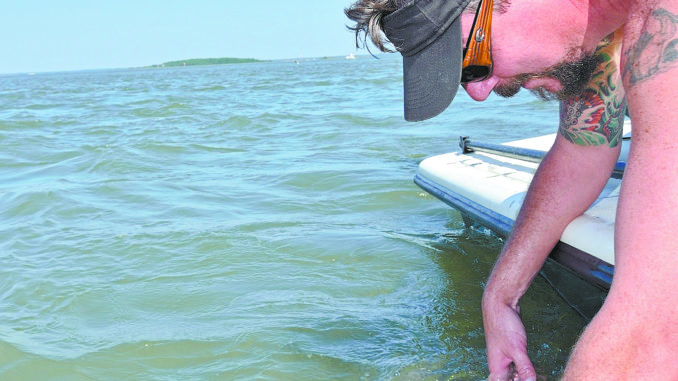
Jetties at Little River are magnets for bull redfish making their way back inshore to spawn. Here’s how to intercept them.
At the tail end of summer, good things come to those who wait. As soon as the annual mullet run begins, the jetties on either side of Little River along the state line become a site of carnage.
Massive schools of burly redfish barge into the areas, filling their bellies with tasty mullet. Anglers from both Carolina converge on the end of both sets of gargantuan boulders to lock into one of these drag destroyers, which have no intentions of being horsed to the surface.
The jetties are a popular destination all year for their deep water, abundant structure and an influx of nutrient-rich water. Even though the estuary inside is relatively small, it is connected to the Waccamaw River system through the Intracoastal Waterway. An enormous influx of shrimp, crabs and fish prosper from these nutrient-rich waters, making Little River a special destination for large, migrating predators.
Some of the biggest speckled trout and flounder of the year, not to mention the huge redfish showing up for the feast as well as other important activities, come from these jetties.
Beginning this month, adult redfish spawn in the large rivers and bays, and even in the inlets where significant current is available. Since most spawning activity occurs at night, feeding ranks at the top of their list during the daylight hours. The influx of baitfish moving through this inlet keeps the redfish fat and happy.
These adult redfish camp out toward the end of each of the jetties through all stages of the tide, excluding the dead tides when current is negligible. But changes in the tide and wind currents will force the fish to various spots around this unique area.
The depths between the jetties vary significantly, with shallow sand bars and a few deep holes approaching 35 feet. Even though these fishing grounds lack a significant surface area, the variable depths, structure and current abnormalities create a large area for these fish to hide.
Capt. Jeff Williamson of Get Busy Fishing Charters out of Ocean Isle Fishing Center shifts his charters excursions from his home base off the Shallotte River to target trophy reds at these famous state line jetty rocks.
He prefers the very tips of the jetties and during the ebb tide.
“The fish will stack up just off jetty points and they work into the current so they are not fighting the current all of the time,” Williamson said.
He deploys a reef anchor, and positions his boat between the tip of the rocks and the channel marker to drop his baits on the falling tide, but the falling tide is not the only feasible tide to catch these fish.
Capt. Patrick Kelly of Captain Smiley Fishing Charters in Little River prefers drifting the rising tide in the confines of the Little River jetties.
“I start my drifts in the ocean and allow the current to push us into the inlet,” Kelly said.
While some of these fish will be confined to certain areas of the inlet, they typically will jockey from place to place as the wind and currents change in intensity.
“They move around a lot, and you need to comb the area to find a concentration of fish,” Kelly said.
Basically, the big reds are trying to ambush passing bait, and any change in depth or current seam will attract them. Tide lines and any type of current rip created by wind and tide will serve as prime places to drift baits. “As the tide line starts coming in, they start biting within the pretty blue water side of the rip,” Kelly said.
The fish will follow the tide line inland, and drifting allows Kelley to keep his baits within the strike zone. He will also briefly anchor within one of these current rips created by wind and tide near the jetty rocks.
“Anchoring up is practical, but with today’s crowds, drifting is preferred and is often more productive,” Kelly said.
Fish will bite on any tide except the slack tides on dead high and dead low. They prefer current. On the falling tide, anglers should drop baits down up next to the rocks near the end of the jetties and along the current rips extending into the ocean. On rising tides, anglers should drift baits between the mouth of the inlet and to the limits of the outer third of the jetty rocks on the inside. Anglers should drop baits all the way to the bottom and then wind in a couple of cranks to prevent hang ups.
When fishing at the reefs, baits should be dropped down on the down current side of the reef structure within a few feet of the rubble.
Any small fish, crustacean or any other marine being on a lower link of the food chain is quite vulnerable, and Kelly uses whatever type of bait is available.
“If mullet are around and easy to catch, use mullet,” he said, “but, menhaden, live shrimp and crab quarters will all work very well. If you believe the fish are down there, sometimes a chunk of blue crab or fresh cut fish will do the trick.”
Few redfish in inshore or nearshore waters will pass up a tender piece of fresh crab, said Kelly, who prepares his crab by removing the hard shell and all of the legs, then cuts the remaining body portion into four equal-sized pieces and threads onto circle hook.
Williamson fishes live bait almost exclusively, with a preference for mullet in a certain size slot.
“A 6- to 8-inch mullet doesn’t stand a chance when these big reds arrive,” he said.
Not only do the big baits catch the eye of the target species, the thousands of black sea bass patrolling the inlet area will typically pass on these jumbo-sized meals.
“Anything smaller will immediately get annihilated by sea bass and a long list of other trash fish,” said Williamson, who will also use larger mullet if he nets any. “(There’s) no such thing as bait too big that will intimidate them.”
Williamson uses a traditional Carolina rig with a 2- to 3-ounce egg sinker and a 1/0 to 2/0 circle hook, but he will keep the live mullet or menhaden just off the bottom since he prefers to fish right next to the structure.
“Drop down, hit bottom, and reel back in a couple of turns to prevent getting hung up so much,” he said.
DESTINATION INFORMATION
HOW TO GET THERE — The Little River jetties and nearshore reefs can be easily accessed from the two public boat ramps — one under the US 17 Bridge in the Intracoastal Waterway in Cherry Grove/North Myrtle Beach and the other at Ocean Isle Beach. The outer third of the jetties and waters all the way to the sea buoy offer the best opportunities to tangle with a bull red. Fish will be on the inside of the jetties on a rising tide and along the points of the jetty on a falling tide. Nearshore reefs from Little River east harbor significant pods of reds, including the Jim Caudle Reef in South Carolina waters and the Jolly Mon, Yaupon and McGlammery reefs in North Carolina waters.
WHEN TO GO — Adult red drum begin to show up around Little River’s jetties in August and will be available through early October or until the major mullet and menhaden schools depart as water temperatures cool.
TACKLE/TECHNIQUES — Live mullet or menhaden between 6 and 8 inches long are preferred. Smaller baits, including live shrimp and pieces of cut blue crab, will get eaten quickly by adult red drum, but by any other fish around. Sometimes when these fish are finicky, fresh cut bait may work. Frozen bait should never be used unless no other options are available. Carolina rigs are preferred with a 2- to 3-ounce egg sinker, a 20-pound monofilmament leader of 12 to 18 inches and a circle hook (1/0 or 2/0 size). Shorter leaders are preferred to produce fewer gut-hooked fish.
GUIDES/FISHING INFO — Capt. Jeff Williamson, Get Busy Fishing Charters, 910-367-064 or www.getbusyfishing.com; Capt. Patrick Kelly, Captain Smiley Fishing Charters, 843-361-7445 or www.captainsmileyfishingcharters.com. Ocean Isle Fishing Center, 910-575-FISH or www.oifc.com. See also Guides & Charters in Classifieds.
ACCOMMODATIONS — Myrtle Beach Area Convention and Visitors Bureau (www.mbchamber.com), South Carolina Association of Visitors Bureaus (www.discoversouthcarolina.com), North Carolina Department of Tourism, www.visitnc.com.
MAPS — Navionics, www.navionics.com, 800-848-5896; Waterproof Charts (Near shore #98) www.waterproofcharts.com, 800-423-9026; Maps Unique, www.mapsunique.com, 910-458-9923; SeaLake Fishing Guides, www.sealakeusa.com, 800-411-0185.

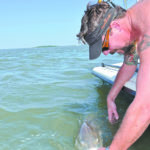
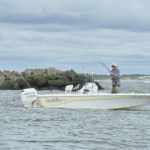
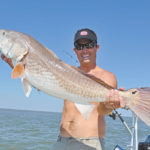
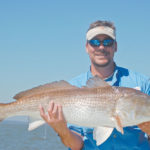
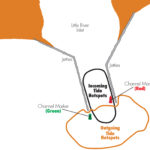




Be the first to comment